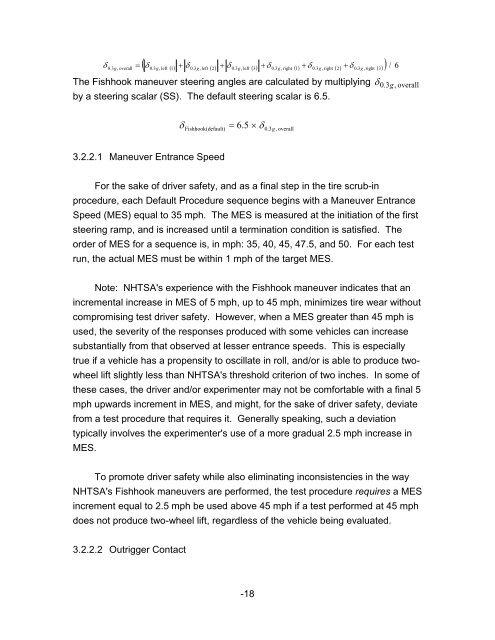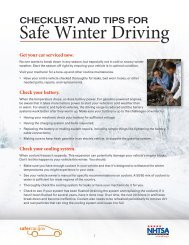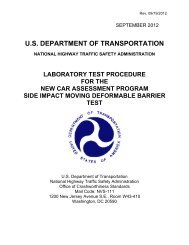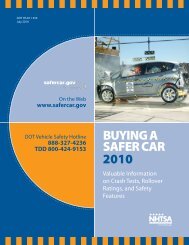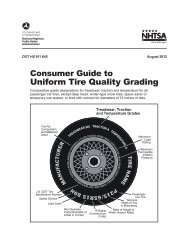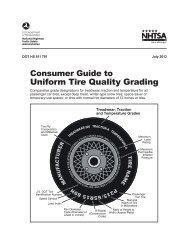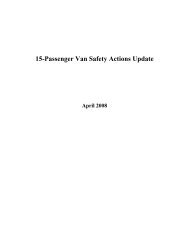Fishhook Maneuver Test Procedure - SaferCar.gov
Fishhook Maneuver Test Procedure - SaferCar.gov
Fishhook Maneuver Test Procedure - SaferCar.gov
Create successful ePaper yourself
Turn your PDF publications into a flip-book with our unique Google optimized e-Paper software.
( δ + δ + δ + δ + δ δ ) / 6<br />
δ =<br />
+<br />
0.3g,<br />
overall 0.3g,<br />
left ( 1) 0.3g,<br />
left ( 2) 0.3g,<br />
left ( 3) 0.3g,<br />
right ( 1) 0.3g,<br />
right ( 2) 0.3g,<br />
right ( 3)<br />
The <strong>Fishhook</strong> maneuver steering angles are calculated by multiplying δ<br />
by a steering scalar (SS). The default steering scalar is 6.5.<br />
0.<br />
3g,<br />
overall<br />
δ × δ<br />
<strong>Fishhook</strong>(default)<br />
= 6.<br />
5<br />
0.3g,<br />
overall<br />
3.2.2.1 <strong>Maneuver</strong> Entrance Speed<br />
For the sake of driver safety, and as a final step in the tire scrub-in<br />
procedure, each Default <strong>Procedure</strong> sequence begins with a <strong>Maneuver</strong> Entrance<br />
Speed (MES) equal to 35 mph. The MES is measured at the initiation of the first<br />
steering ramp, and is increased until a termination condition is satisfied. The<br />
order of MES for a sequence is, in mph: 35, 40, 45, 47.5, and 50. For each test<br />
run, the actual MES must be within 1 mph of the target MES.<br />
Note: NHTSA's experience with the <strong>Fishhook</strong> maneuver indicates that an<br />
incremental increase in MES of 5 mph, up to 45 mph, minimizes tire wear without<br />
compromising test driver safety. However, when a MES greater than 45 mph is<br />
used, the severity of the responses produced with some vehicles can increase<br />
substantially from that observed at lesser entrance speeds. This is especially<br />
true if a vehicle has a propensity to oscillate in roll, and/or is able to produce twowheel<br />
lift slightly less than NHTSA's threshold criterion of two inches. In some of<br />
these cases, the driver and/or experimenter may not be comfortable with a final 5<br />
mph upwards increment in MES, and might, for the sake of driver safety, deviate<br />
from a test procedure that requires it. Generally speaking, such a deviation<br />
typically involves the experimenter's use of a more gradual 2.5 mph increase in<br />
MES.<br />
To promote driver safety while also eliminating inconsistencies in the way<br />
NHTSA's <strong>Fishhook</strong> maneuvers are performed, the test procedure requires a MES<br />
increment equal to 2.5 mph be used above 45 mph if a test performed at 45 mph<br />
does not produce two-wheel lift, regardless of the vehicle being evaluated.<br />
3.2.2.2 Outrigger Contact<br />
-18


